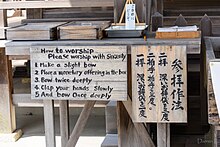Two bows, two claps, one bow


"Two bows, two claps, one bow" (二礼二拍手一礼) is a ritual people do when they enter Shinto shrines. As the name suggests it involves bowing twice, clapping twice, and then bowing once more.[1][2][3][4][5]
To show respect for the gods, it is important to follow proper etiquette, with "two bows, two claps, one bow" being the most commonly used method. This ritual has evolved over time and is a reflection of the respect and reverence for the deities.."[6]
While there have been various historical systems, this is the current one that is used now.[7]
This method is widely considered as the standard when visiting shrines[8] However, there may be some local variations depending on the specific shrine.[6]
The practice of "two bows, two claps, one bow" is also sometimes referred to as "2-2-1".[9]
Procedure[change | change source]
The procedure goes as follows[10][11]
- Bow once before entering Torii[10][11][2]
- Purify hands and mouth with chozuya[10][11][2]
- Put money in the offering box[12][2][6]
- Ring the bell 2-3 times if present[13][6]
- Bow twice[10][11][2] [6]
- Clap twice[10][11][2] [6]
- Bow once[10][11][2] This bow should be deeper than the others[14] at a 90-degree angle[6]
History[change | change source]
The practice of "two bows, two claps, one bow" can be traced back to the "Shrine Festival" in 1873, where it was referred to as Reworship and applause (再拝拍手, saibai hakushu) Over time, different methods were developed and refined, resulting in the current etiquette. In the 40th year of the Meiji era, the "Shrine Rituals and Events Etiquette" was established, which defined the etiquette as "returning, clapping twice, pressing together, praying, praying, clapping twice, and bowing again."[6]
It is widely acknowledged that "two bows, two claps, one bow" is the formal etiquette of worship for the chief priest. This etiquette was developed through the extensive experience and improvements made by the predecessors and is a testament to the reverence and respect for the gods.[6]
Other pages[change | change source]
References[change | change source]
- ↑ "How many times should you bow and clap at the shrine? (Tips #2)". Akemi's Blog. Retrieved 2023-04-08.
- ↑ 2.0 2.1 2.2 2.3 2.4 2.5 2.6 2.7 "How to worship correctly at temples/shrines [with images] | Living in JAPAN". Living in JAPAN | Living in Japan is a web magazine dedicated to foreign nationals. We provide a lot of useful information such as Japanese culture and manners to navigate life in Japan. We also provide job hunting and VISA support. 2019-05-23. Retrieved 2023-04-08.
- ↑ D, John (2019-02-17). "First steps in Shinto". Green Shinto. Retrieved 2023-04-08.
- ↑ "The Basics of Shrine Visiting! Must-Know Information and Some Recommended Shrines in Japan". The KANSAI Guide - The Origin of Japan, KANSAI. Retrieved 2023-04-08.
- ↑ "American Shinto Community of Practice: Community Formation outside Original Context - ProQuest". www.proquest.com. Retrieved 2023-04-08.
- ↑ 6.0 6.1 6.2 6.3 6.4 6.5 6.6 6.7 6.8 "二礼二拍一礼は参拝の基本。その歴史と考え方とは。|葬儀・家族葬なら【よりそうお葬式】". www.yoriso.com (in Japanese). Retrieved 2023-02-11.
- ↑ Wanderingmonk19 (2017-07-13). "Shinto Manner of "Two Bows, Two Claps and One Bow" Set as the Standard by God's Will". ISE-HAKUSAN DOU'S "THE UNIVERSE". Archived from the original on 2023-02-12. Retrieved 2023-02-12.
{{cite web}}: CS1 maint: numeric names: authors list (link) - ↑ "ETIQUETTE'S AT SHRINES". Hello! Tokyo Tours. Retrieved 2023-02-12.
- ↑ Bagarino, Christine (2018-03-15). "How to Pray at a Japanese Shinto Shrine". Culture Trip. Retrieved 2023-02-12.
- ↑ 10.0 10.1 10.2 10.3 10.4 10.5 "Do you know? Shrine manners and their meanings | Feel Fukuoka Japan". 2015-08-21. Retrieved 2023-02-12.
- ↑ 11.0 11.1 11.2 11.3 11.4 11.5 11.6 https://archive.today/20230408002726/https://www.yakult.co.jp/english/inbound/manners/05.html
- ↑ "Learn about Shinto - How to behave in a shinto shrine". 供TOMO ONLINE STORE. Retrieved 2023-02-12.
- ↑ Japanistry (2016-11-06). "Visiting Shrines & Temples in Japan: Etiquette & Customs". japanistry.com. Retrieved 2023-04-08.
- ↑ "Pray|Ise Jingu". Ise Jingu. Retrieved 2023-02-12.
